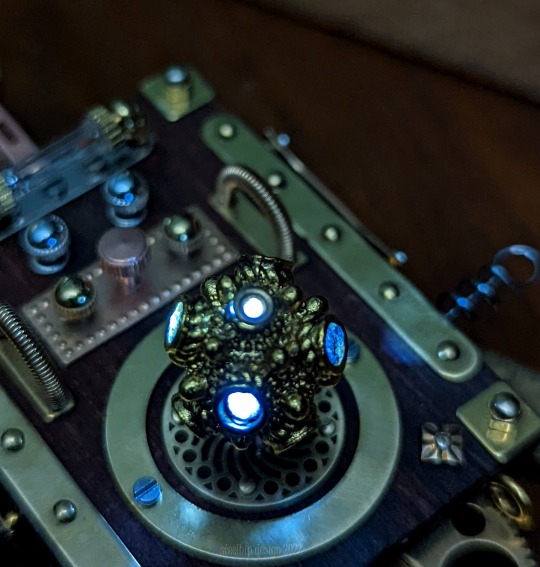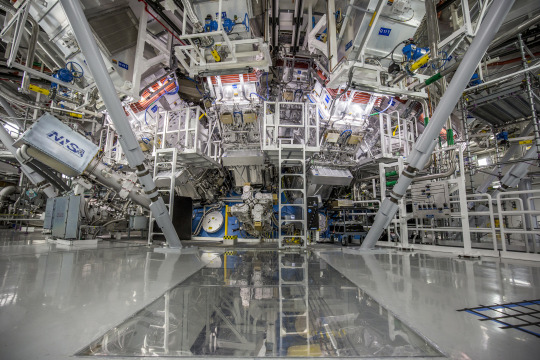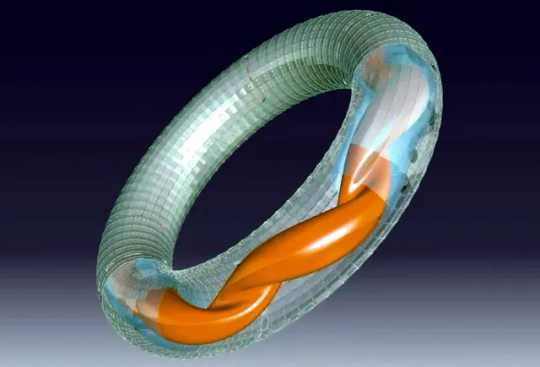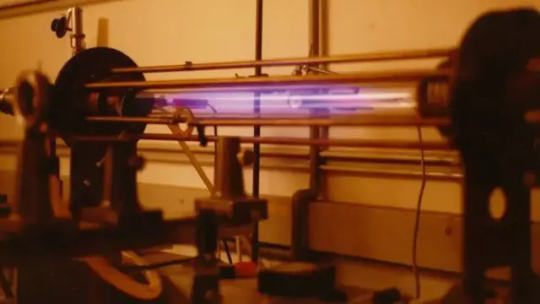#Tokamaks
Photo

Tokamak experiments provide unique data for validating spacecraft heat shield ablation models
When a spacecraft enters a thick atmosphere at a high velocity, it rapidly compresses the gas in front of it. This creates temperatures high enough to ionize the gas molecules into a hot, dense plasma. To protect against damage, spacecraft are typically covered by a heat shield material that burns in a controlled manner. This process is called ablation. Though current materials are effective for present-day missions, future missions require better heat shields.
To help develop them, scientists for the first time used a device known as a tokamak to study what happens to these materials in a hot plasma. In a series of experiments, the team exposed stationary graphite rods to the plasma near the floor of the tokamak. They then injected small carbon pellets deeper into the core of the plasma to observe how different carbon-based materials burn in conditions relevant to spacecraft entry into atmospheres.
Tokamaks are donut-shaped devices that can trap plasmas with strong magnetic fields. Scientists primarily use these devices for research into fusion energy. Conditions in a tokamak plasma can be similar to those experienced during some of the most challenging space missions ever attempted, such as the Galileo probe entry into Jupiter's atmosphere. Although the Galileo mission was successful, its heat shield occupied about half the mass of the probe. This left little capacity for scientific instruments.
Read more.
23 notes
·
View notes
Text

In-vessel cables transmit signals and power between the vacuum vessel and the buildings. They are present in all areas—attached to vacuum vessel sectors, behind blanket modules, under the divertor, and in upper and lower ports. (via iter.org, WHAT IT TAKES TO WIRE UP A FUSION REACTOR by Pat Brans)
22 notes
·
View notes
Photo

Infinite Lagrange - Tokamak by Yishu 5
64 notes
·
View notes
Text

Do you work for C.O.G.S. Inc., mr. Jet?
Old picture
2 notes
·
View notes
Text




Magnetosphere
This started with an amazing bead! I drilled out every "hole" in it and suspended a tiny LED in it. The lighting is a bit more subtle than the other panels I've made but this has a lot of other bits and pieces going on.
I've been amazed at the recent scientific breakthroughs with fusion reactors in Korea and China. I not on love the possibility of abundant clean energy in the future but I also love the names of these experimental machines like Tokamak, Stellarator, Magnetic Mirror, Toroidal Z-pinch, Spheromak. They really do evoke fantasies of portals to a parallel universe or bending space time - the only way we will be able to travel those distances. Einstein's relativity really did take a dump on the possibility to live in a Star Trek type reality.
So this contains an array of "controls" including watch crown "dials". It has a tiny glass fuse (or it could be a magnetic switch - not sure) and spring wire tubing. It is the only panel to feature a clock gear. I love gears - it was one of the reasons I was drawn to the steampunk aesthetic. But, and this is controversial and just my opinion, I think gears are used far too much.
Way back in 2010 there was the "slap a gear on it" by those just wanting to jump on (and profit from) the zenith of the steampunk trend. I use gears sparingly, often not using them at all, and rarely an "orphan" gear. They have to look like they have an actual use in the "machine" even if they don't move. In this design I want the gear to look like it's doing something behind the scene.
If there was such a think as a 6 volt coin battery I would have also back lit the amazing "swirl" stamp at the base of the main feature. Just have to wait for those to be in production. The wire "aerials" coming out of the side of the panel is fishing tackle. To balance the piece I finished it with a small copper strut and brass wheel.
This piece does deserve it's own stand. I will make a special one for it and include another LED to it. It will also come with a standard brass chain.
#fusion#steampunk#steampunk jewelry#steam punk#steelhipdesign#handmade#steampunk art#mad scientist#science jewelry#pendant#miniature#fusion reactor#spherical tokamaks#spheromak#sci fi#science#scientific#scifi#scifiart#energy#machine#light#light up#experimental#scientific instruments#fantasy jewelry#fantasy#fantasy art#science fantasy#contol panel
58 notes
·
View notes
Text
tumblr would, and perhaps indeed should, go crazy for guin sard rhineford
#turn a gundam#ultimate tumblr sexyman#he left his moral compass in a tokamak#he does good things for bad reasons and then bad things for worse reasons#he's even gay
12 notes
·
View notes
Text
2 notes
·
View notes
Text
„Ich komme aus dem Prepperbunker raus voller Ekstase
Und ein paar Spinner wollen Autogramme auf die Atemmaske
Rokko Weissensee befindet sich in der Endphase
Die Releases meiner Alben zählt man jetzt in Hundejahren
Pisse, Kacke, Scheiße du siehst aus wie überfahren
Man kennt mich auf der Straße als den Mann ohne Gnade
Ich warte unter Tage bis die Zungen alle schwarz sind
Ich lebe international: Ich bin farbenblind
Rokko Weissensee ich war das erste Straßenkind
Früher war ich fröhlich, heute spritz ich Sputnik V
Du musst deine Feinde treffen, so dass sie das Sterben fühlen
Erst wenn ich die Welt verlasse werden Bäume wieder grün
Die Beschissenheit der Dinge ist alltäglich und präsent
Ich schlage dich tot denn du redest permanent
Im Tokamak-Fusionsreaktor wurde ich zum Mann
Wenn du mich in Frage stellst, fehlen dir Wissen und Verstand“
- Rokko Weissensee
#deutschrap#hiphop#rap#germanrap#deutsch#german#rokko weissensee#tokamak#einsam sterben die tapferen#upstruct#Spotify
2 notes
·
View notes
Text
Admiral's comments on fission hold for fusion 70 years later
Admiral’s comments on fission hold for fusion 70 years later
Last month the US Energy Secretary, Jennifer Granholm announced a successful experiment at the Lawrence Livermore National Laboratory in which 192 lasers were used to pump 2.05 mega Joules of energy into a capsule heating its contents to 100 million degrees Centigrade causing fusion of hydrogen nuclei and the release of 3.15 mega Joules of energy. An apparent gain of 1.1 mega Joules until you…

View On WordPress
#Admiral Rickover#Engineering#fusion energy#hydrogen#innovation#Lawrence Livermore Laboratory#nuclear energy#power stations#spherical tokamak energy production#STEP
2 notes
·
View notes
Link
“Researchers at the U.S. Department of Energy's (DOE) Princeton Plasma Physics Laboratory (PPPL) have found that updating a mathematical model to include a physical property known as resistivity could lead to the improved design of doughnut-shaped fusion facilities known as tokamaks.”
“Scientists have discovered a new way that resistivity can cause instabilities in the plasma edge, where temperatures and pressures rise sharply. By incorporating resistivity into models that predict the behavior of plasma, a soup of electrons and atomic nuclei that makes up 99% of the visible universe, scientists can design systems for future fusion facilities that make the plasma more stable.“
“Fusion, the power that drives the sun and stars, combines light elements in the form of plasma—the hot, charged state of matter composed of free electrons and atomic nuclei—and generates massive amounts of energy. Scientists seek to harness fusion on Earth for a virtually inexhaustible supply of power to generate electricity.”
article
#physics#plasma physics#energy#electricity#flow#nuclear energy#tokamak#clean energy#temperature#nuclear fusion#ITER#safire project#solar energy#energy evolution#states of matter#electromagnetism
4 notes
·
View notes
Link
What is the connection between boron, an element in a common household cleaner, and tokamaks, ring-shaped fusion facilities that heat fuel to million-degree temperatures? Scientists at the U.S. Department of Energy's (DOE) Princeton Plasma Physics Laboratory (PPPL) have conducted research showing that a PPPL-developed powder dropper can successfully drop boron powder into high-temperature plasma within tokamaks that have parts made of a heat-resistant material known as tungsten. Scientists want to confirm they can use this process to apply boron to tungsten parts because bare tungsten walls can hurt plasma performance if the plasma damages the tungsten.
Because of its high melting point, tungsten is increasingly used in tokamaks to help components withstand the intense heat of the fusion process. Boron partly shields the tungsten from the plasma and prevents the tungsten from leaking into the plasma; it also absorbs any stray elements like oxygen that may be in the plasma from other sources. These unwanted impurities could cool the plasma and quench the fusion reactions.
"We need a way to deposit boron coatings without turning off the tokamaks' magnetic field, and that's what the powder dropper allows us to do," said Grant Bodner, a postdoctoral researcher at PPPL who was the lead author of the research paper reporting the results in Nuclear Fusion. The research was performed using the W Environment in Steady-State Tokamak (WEST), operated by France's Atomic Energy Commission (CEA). "WEST is one of the few full-tungsten environments that can help us test this technology at long pulses," Bodner said.
Read more.
22 notes
·
View notes
Text

Top Ten Reasons for ITER
36 notes
·
View notes
Photo

Breakthrough in Fusion Energy: Scientists Create Innovative Nuclear Fusion Device Using Household Magnets | www.ceboz.com
Scientists at the U.S. Department of Energy’s Princeton Plasma Physics Laboratory (PPPL) have achieved a groundbreaking milestone in fusion energy technology by constructing a novel fusion experiment called MUSE. This innovative device relies on permanent magnets, a departure from traditional electromagnets, potentially revolutionizing the cost-effectiveness of future fusion power plants.
#Nuclearfusion#Fusionpower#Stellarator#PrincetonPlasmaPhysicsLaboratory#Magnet#Plasma#Physics#Tokamak
1 note
·
View note
Text
El Sol Artificial de Corea del Sur supera siete veces la temperatura de núcleo del Sol

El Sol Artificial de Corea del Sur supera siete veces la temperatura de núcleo del Sol
Un grupo de científicos surcoreanos han establecido un nuevo récord mundial utilizando el dispositivo de Investigación Avanzada del…
LEE MÁS
0 notes
Text
Fusione nucleare Z-pinch MIFTI raggiunge un guadagno

Raggiunta la fusione nucleare con il metodo del confinamento ibrido magnetico inerziale. MIFTI, Magneto Inertial Fusion Tecnology Inc, guidata dal presidente e scienziato capo Dr. Hafiz Rahman, ha recentemente dimostrato la sua tecnologia di fusione ibrida magnetico inerziale presso l’L3 Harris Lab di San Leandro, in California, dove ha prodotto un’incredibile resa di 150 miliardi di neutroni, che soddisfa tutte le previsioni delle simulazioni informatiche sulla fusione.
Si tratta di un risultato 10.000 volte superiore a quello ottenuto da qualsiasi altra azienda privata al mondo nel settore della fusione nucleare.
La fusione magnetico inerziale è una forma di fusione in cui il plasma viene compresso e riscaldato sino alla fusione nucleare utilizzando da un lato il confinamento magnetico a cui si aggiungono per pressione e calore.
Quindi si tratta, potremmo dire, di una modalità ibrida che unisce il sistema di confinamento magnetico e l’applicazione di pressione e calore. Una macchina che funziona solo con la fusione magnetica è il Tokamak.
Simulazioni avanzate hanno dimostrato che, portando il generatore di fusione di MIFTI a 10 Mega Ampere, si dovrebbe ottenere un guadagno netto di energia e consentire la produzione commerciale di isotopi medici, di cui c’è un disperato bisogno per la scansione dei tumori negli ospedali.
US Nuclear è un partner, un investitore e un possibile appaltatore principale per il generatore di energia a fusione di MIFTI ed è in attesa di ulteriori sviluppi. L’utilizzo dei neutroni per la produzione di isotopi radioattivi è un primo passo per lo sfruttamento economico della fusione, in attesa che il guadagno energetico sia tale da permettere la costruzione di vere e proprie centrali a fusione.

Esempio di contenimento Z Pinch
Le continue scoperte tecnologiche e il grande afflusso di finanziamenti hanno accelerato rapidamente lo sviluppo dell’energia da fusione. Gli investimenti nell’industria globale della fusione sono saliti alle stelle, raggiungendo un totale di 6,21 miliardi di dollari, rispetto ai 4,8 miliardi di un anno fa.
L’anno scorso, il Lawrence Livermore National Lab è stato il primo a raggiungere un guadagno netto di energia positivo, aprendo la strada alla commercializzazione dell’energia da fusione, e Microsoft ha recentemente firmato il primo accordo al mondo per l’acquisto di energia da fusione commerciale da Helion Energy a partire dal 2028.
MIFTI è unica nel suo genere in quanto è l’unica azienda al mondo ad aver sviluppato un metodo di fusione Z-pinch a stadi fino a raggiungere un’emissione massiccia di energia attraverso la produzione di neutroni.
Il loro approccio speciale presenta molti vantaggi che li renderanno leader nella produzione di energia da fusione. Il sistema Z Pinch riesce a raggiungere il confinamento magnetico tramite una corrente elettrica che scorre lungo l’asse Z, da cui il termine “Z Pinch”.

MIFTI è stata fondata nel 2008 da scienziati della UC Irvine, che hanno dedicato oltre 25 anni alla ricerca e allo sviluppo della loro speciale tecnologia di fusione Z-pinch a stadi. Anni di sperimentazione, comprensione e modellazione avanzata hanno dimostrato che l’approccio alla fusione Z-pinch di MIFTI può risolvere i problemi energetici del mondo fornendo un guadagno netto di energia da dieci a cinquanta volte l’energia utilizzata per attivare il processo.
Inoltre, l’approccio Z-pinch a stadi è molto flessibile e può essere utilizzato per numerose applicazioni, tra cui la produzione di isotopi per la scansione medica senza l’utilizzo di complessi, costosi e rari reattori a fissione nucleari.
Read the full article
#centralenucleare#confinamentoibrido#energia#fusionenucleare#fusioneZ-pinch#Helionenergy#MIFTI#Tokamak#Z-pinch
0 notes
Link
Inside there is plasma heated to 200 million °C The world's largest experimental thermonuclear reactor has begun operation in Japan. The technology is in its infancy, but some see it as the answer to humanity's future energy needs. Fusion differs from fission, a method currently used in nuclear power plants, in that the process fuses two atomic nuclei instead of splitting one. The purpose of the JT-60SA reactor is to explore the possibility of nuclear fusion as a safe, large-scale and carbon-free source of clean energy that produces more energy than it costs to produce it. The six-story structure, located in a hangar in Naka, north of Tokyo, is a tokamak vessel shaped like a torus, containing swirling plasma heated to 200 million degrees Celsius. [caption id="attachment_85609" align="aligncenter" width="780"] thermonuclear fusion[/caption] A milestone in the history of thermonuclear fusion This joint project of the European Union and Japan is the predecessor of its "big brother" in France - the International Thermonuclear Experimental Reactor (ITER) under construction. The ultimate goal of both projects is to force the hydrogen nuclei inside to fuse into one heavier element, helium, releasing energy in the form of light and heat and mimicking the process that occurs inside the Sun. Sam Davis, JT-60SA's deputy project manager, said the device would "bring us closer to fusion power." “This is the result of collaboration between more than 500 scientists and engineers and more than 70 companies across Europe and Japan,” Davis said. EU Energy Commissioner Kadri Simson said the JT-60SA is “the most advanced tokamak in the world,” calling the start of operation “a milestone in the history of fusion.” “Fusion has the potential to be a key component of the energy mix in the second half of this century,” Simson added.
#clean_energy#controlled_nuclear_fusion#energy_technology#fusion_energy_production#fusion_energy_research#fusion_power#fusion_reactions#fusion_reactors#future_energy_sources.#inertial_confinement#magnetic_confinement#nuclear_fusion#nuclear_fusion_experiments#nuclear_fusion_reactor#nuclear_physics#plasma_confinement#Sustainable_Energy#sustainable_power_generation#thermonuclear_fusion#tokamak
1 note
·
View note